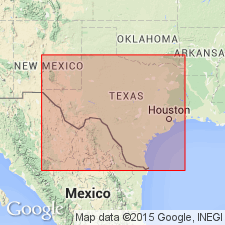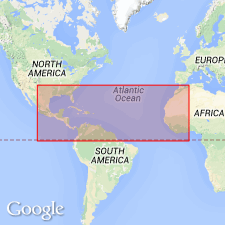
- Usage in publication:
-
- Reynosa limestone
- Modifications:
-
- First used
- Dominant lithology:
-
- Limestone
- AAPG geologic province:
-
- Gulf Coast basin
Summary:
First used in Gulf Coast basin: "The Mexican town of Reynosa, in the State of Tamaulipas, on the Rio Grande, is situated on a hill rising some fifty feet above the level of the river and composed of a hard white limestone. This is made up of very hard calcareous nodules, one-half inch to over three inches in diameter, white to creamy-brown in color, and in places showing a concretionary structure imbedded in soft white material of the same composition. This deposit lies on the sands of the Fayette series, which are exposed at the water's edge. Though usually hard, yet in places on the surface it is soft and crumbly, and in this softer material were found many specimens of BULUMULUS ALTERNATUS, Say., a shell found now in great quantities on the Rio Grande. These prove the late origin of at least the material in which they were imbedded, and it apparently blends into the harder rock. *** though it is probably true that the whole of the limestone is of the same late origin, its relations and extent have not been studied. *** Similar limestones are said to be found in various parts of Hidalgo County, and that in digging wells they are passed through for about thirty feet, when they find water in an underlying sand or sandstone (Fayette Beds?)."
Source: GNU records (USGS DDS-6; Denver GNULEX).

- Usage in publication:
-
- Reynosa beds
- Modifications:
-
- Overview
- Areal extent
- AAPG geologic province:
-
- Gulf Coast basin
Summary:
Previously described under the name Reynosa limestone (Penrose, 1890). Observed along the line of the Southern Pacific railway between San Antonio and Eagle Pass, deposit usually consisting of a larger or smaller quantity of gravel cemented by a very porous or tuffaceous limestone; in some places, gravel seemed missing and only the limestone present. Same deposit noticed north of Eagle Pass and forming the summits of the hills at many localities along the Rio Grande between Eagle Pass and Edinburg; thickness from 3-30 ft, and sometimes overlain by yellow silt. At Reynosa, Tamaulipas, MX and opposite Edinburg, TX, a much larger and firmer limestone deposit occurs that was previously designated Cretaceous limestone, but contains such fossils as BULIMUS ALTERNATUS, thus showing it to be much younger. Is also noted to occur up the valleys of the Nueces and Leona rivers. Extends the name to include the entire series of such deposits that cover a very large area in western TX and extend into MX. Is tentatively correlated with Lafayette formation in the Colorado River section. Age is Neocene.
Source: GNU records (USGS DDS-6; Denver GNULEX).
For more information, please contact Nancy Stamm, Geologic Names Committee Secretary.
Asterisk (*) indicates published by U.S. Geological Survey authors.
"No current usage" (†) implies that a name has been abandoned or has fallen into disuse. Former usage and, if known, replacement name given in parentheses ( ).
Slash (/) indicates name conflicts with nomenclatural guidelines (CSN, 1933; ACSN, 1961, 1970; NACSN, 1983, 2005, 2021). May be explained within brackets ([ ]).

